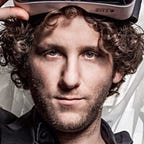How to make humans dance together in a virtual party?
Since pandemic started we seen some attempts to create virtual dance floors.
Set up the tech to live stream
Place people dancing in a „boiler-room” on the background of DJ
Invite hundreds of people on social,
And you have a dance party…
Or actually you don’t.
Currently, online dance festivals are looking for amazing visuals to the party world and DJ performance. But in my opinion, the focus should be on the dance sensation inside the crowd. A collective dance ritual. Bellow an example of a very impressive DJ set but no social dance floor.
I’ve been exploring carefully the evolution of DJ sets along the last months, in most cases, people have their camera off, if the video is on people either sit and look or talk with friends in their mini-house party. Very few people dancing, most importantly very few people dancing with each other.
It made me wonder…
- What is the purpose of a dance floor and how can we recreate it in a virtual space?
Discoteqcue in Latin is actually the library of discussions, Space where we socially exchange in a non-verbal way, as animals we exchange through our movement, frequencies, and hormones.
- What’s the role of the DJ?
Some say the quality of a DJ performance consists of two main features: technical skills and the ability to select the most suitable recordings, also known as „reading the crowd“. Basically to work out what the crowd wants the DJ looks for clues on the dance floor.
- Who is dancing to what music?
- Who is tapping their head or feet to the beat
- Who is looking at the dance floor and about to start dancing?
The Human Jockey
There are additional skills a DJ would need to get people to dance online together. The crowd control works differently, you need to animate the humans, not only curate the soundtrack. The Human Jockey is more similar to The Disc Jockey in the Ice ring, who makes various announcements to activate the ice skaters, or to the “Saturday night fever DJ” who would initiate a battle between dancers. The Human Jockey is responsible for encouraging the online revelers to enter collective make-believe.
What usually happens when you enter a ‘zoom party’/DJ Livestream?
You enter the site/app and see video boxes on your phone/computer. Some boxes are only names, some are with video but the person is not dancing. One of the people is playing music, they look like a DJ.
In this stage people would be divided into the following groups:
1/ Exhibitionist: open their camera and dance.
2/ Here to watch: open a camera sit and watch.
3/ Here to dance: stay hidden and dance.
4/ Here for the music: stay hidden and wash the dishes.
5/ Voyeurism: stays hidden and look at people.
In the case of 3, dance alone by yourself, you are parting inwardly. This is like dancing to loud music in your room or doing a meditation course on a podcast it’s not social. In the case of 2–5, you are not really helping to create a virtual dance floor. It’s only the first option which we would consider as being an exhibitionist, that allows virtual social dancing to take place.
How do you encourage people to open their camera and dance?
The Human Jockey role is to bring the participants in the video call to show themself without the judgment that this as a strange exhibitionist act, but recognizing they are becoming a part of a collective body. Co-Reality collective helped me create this video explainer which is a step by a step action plan to rock your virtual dance floor.
What do the future of online dance floors and virtual performances entail?
It seems humans need this physical and hormonal exchange. In the meantime, Virtual non-lingual gatherings would accelerate our evolution to become a collective organism. On the way, we will discover we could exchange content, ideas, and possibly even resolve conflicts on the dance floor.
Back in 2010, I directed a version of Romeo & Juliet that took place in a night club. We tried to discuss serious issues of social injustice in our society through the dance floor. I believe If we use it the right way, the virtual dance floor can be a key to surface many of the challenges of our times and resolve them through a collective dance.
Michael Ronen is a futurist, an experience designer, business consultant for future proof enterprises, digital event producer, and facilitator for the virtual work era.
Michael started as an Immersive theater director who founded ‘Conflict zone arts asylum’ a network of artists from conflict zones. He later founded tech startups: Splash mobile VR (licensed to GIPHY) and Capsuling.Me (Virtual time capsules). Recently founded Wonderland Immersive Design, an agency for digital experience design, helping organizations such as Kinnernet, DLD & YPO transform their events into the virtual space.
Follow me: Instagram / Linkedin / Twitter
Contact me M@wonderlandimmersivedesign.com
